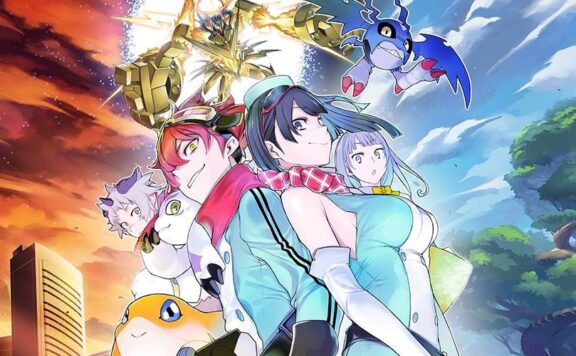The Digimon series’ blend of hard-to-swallow themes and real life issues with power-of-friendship anime shenanigans usually leans most heavily on the latter. Deaths in the family or missing children might linger in the background of the story, but most of the focus remains on chipper kids teaming up with half-naked angel women and talking machine-gun-bunnies to defeat a digital manifestation of the devil on a motorcycle. Digimon Survive flips the script and goes in an unexpectedly more mature direction, delivering heavy-hitting moments of trauma, on top of characters who you’ll need to bond with if you want to prevent their gruesome deaths. It’s a heavy-hitting visual novel experience, but some pacing issues and barebones tactics-gameplay diversions muddy the full package.
Digimon Survive kicks off when protagonist Takuma and the rest of his class go on a culture trip to a small town surrounded by shrines and other historical landmarks. Their trip is happening in the middle of a series of sudden earthquakes and landslides across the region, though, and these natural disasters soon impede the otherwise innocent summer trip. While the opening hours are pretty glacial, they set up a really intriguing and genuinely unnerving story – Takuma and his tight crew end up meeting characters native to the town who talk about a mysterious unmarked temple, but when the gang gets separated and Takuma’s group navigates through an abandoned tunnel to try and locate the rest, they end up in a field full of red death lily’s, where the weather has reversed. To our heroes, they theorize that they’re stuck in some sort of eerie ghost-fueled underworld or suffering from hallucinations. To any Digimon fan, though, their whereabouts become immediately clear; they’ve landed in the digital world, where Digimon roam and reign.
Digimon Survive has a lot of impressive ideas that get doled out across its twelve story chapters. For the first half of the game, these nuggets are delivered a bit too slowly – for every hour of eye-opening character development or mysterious happenings, there are about five accompanying hours of repetitive conversations and meandering thoughts that don’t go anywhere worthwhile. Contributing to the sometimes tepid pacing of the story is that the narrative meat of the game is split between dialogue scenes and “exploration” scenes, with exploration moments tasking you to navigate your cursor around the screen to manually click on characters and items of interest to trigger dialogue, or pull up the map to maneuver to the zone containing your next plot-relevant conversation.

It’s a bit of a slog for sure, but visual novel veterans will likely be able to forgive these tepid opening chapters – especially when the back-half of the game opens up with shocking moments, revelatory answers, and huge narrative diversions depending on which characters you bond with.
Bonding with your favorite cast members won’t just help them avoid an early demise, it will also benefit you in the game’s less frequent and far less engaging tactical battles. Digimon Survive is not a robust, fully-fledged tactical RPG like Fire Emblem – it’s far more comparable to a game like Utawarerumono, where the visual novel experience is broken up now and then with simple tactical battle encounters.
In Digimon Survive, your digital monsters duke it out with incredibly barebones movesets – each one has a basic attack and one or two special attacks, and can reposition on the sides or back of an enemy to dish out bonus damage. The biggest modifier introduced here is the ability for Digimon to digivolve if you’ve bonded enough with their human counterpart, and these digivolved beasts can steamroll every encounter in the game.

I appreciate when a visual novel provides some kind of tactile, gameplay moment that breaks up the monotony of trawling through dialogue boxes. In that context, the battles in Digimon Survive are serviceable. There’s little strategy, little difficulty, and little variety, but if you just want something quick to do to keep things fresh as you progress through the story, they’re harmless. You can enable auto-battles or animation skips to power right through them if you hate them, but if you’re trying to get more out of the tactics side of the game, don’t push it. The most you’re going to get in that aspect is the ability to grind out battles for the chance to recruit new Digimon, similar to Shin Megami Tensei demon-negotiation. It’s an innocent enough bonus, but ultimately one that feels like wasted effort when the overall tactics are so slim.
Don’t go into Digimon Survive looking for a gripping tactics RPG – from that perspective, the game is a huge disappointment – but as a visual novel, this is a very worthwhile experience. Sure, the opening chapters can be pretty slow and tepid at times, but those moments make way for some really gripping developments that deliver the most horror-adjacent tone I’ve ever seen in the Digimon world. If anything else, Digimon Survive creates the framework for a blend of narrative and tactics that can only get better if Bandai Namco decides to tackle a sequel in the future.



